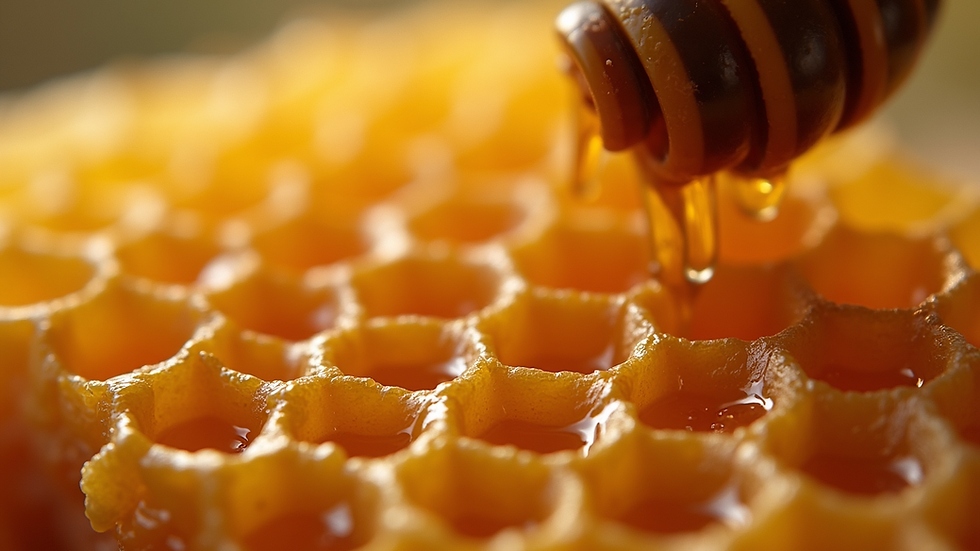Mastering Honey Extraction Techniques at Home
- honeybee303
- Sep 19
- 4 min read
Honey is a sweet gift from nature, and extracting it at home can be a rewarding experience. Whether you are a seasoned beekeeper or just starting out, mastering honey extraction techniques can enhance your enjoyment of this delicious product. In this post, we will explore the various methods of honey extraction, the tools you need, and tips to ensure you get the best quality honey.
Understanding Honey Extraction
Honey extraction is the process of removing honey from the honeycomb. This can be done in several ways, depending on the equipment you have and the scale of your operation. The two most common methods are using a honey extractor or crushing and straining the honeycomb.
The Honey Extractor Method
A honey extractor is a device that uses centrifugal force to remove honey from the comb. This method is efficient and preserves the integrity of the honeycomb, allowing bees to reuse it.
Choosing the Right Extractor
When selecting a honey extractor, consider the following:
Size: Choose an extractor that fits your needs. For small-scale beekeeping, a manual extractor may suffice. Larger operations may require an electric model.
Material: Stainless steel extractors are durable and easy to clean. Plastic extractors are lighter but may not last as long.
Type: There are two types of extractors: radial and tangential. Radial extractors spin the frames around a central axis, while tangential extractors spin frames on their sides. Radial extractors are generally more efficient.
Crushing and Straining Method
If you do not have an extractor, you can still extract honey by crushing the comb and straining the honey. This method is simpler but may result in a less clear product.
Steps for Crushing and Straining
Remove the Honeycomb: Cut the honeycomb from the frames using a sharp knife.
Crush the Comb: Place the comb in a bowl and crush it with a fork or potato masher. This will release the honey.
Strain the Honey: Pour the crushed comb through a fine mesh strainer or cheesecloth to separate the honey from the wax.
Collect the Honey: Allow the honey to drain into a clean container.
Essential Tools for Honey Extraction
Having the right tools can make the honey extraction process smoother and more efficient. Here are some essential tools you will need:
Honey Extractor: As mentioned earlier, this is the primary tool for extracting honey.
Uncapping Knife: This knife is used to remove the wax capping from the honeycomb cells before extraction.
Strainer: A fine mesh strainer or cheesecloth is necessary for filtering out wax particles.
Containers: Use clean, food-grade containers to store your honey.
Bee Suit and Gloves: Protect yourself while working with bees and honey.
Best Practices for Honey Extraction
To ensure you get the best quality honey, follow these best practices:
Timing is Key
Extract honey when it is at the right moisture content. Honey should ideally have a moisture content of around 18%. If it is too wet, it may ferment. Check the moisture content using a refractometer.
Work in a Clean Environment
Cleanliness is crucial in honey extraction. Make sure all your tools and containers are sanitized to prevent contamination.
Handle Honeycomb Gently
Be gentle when handling the honeycomb to avoid crushing it unnecessarily. This will help maintain the quality of the honey.
Store Honey Properly
Once extracted, store honey in a cool, dark place. Use airtight containers to keep it fresh. Honey can last indefinitely if stored correctly.
Troubleshooting Common Issues
Even with the best techniques, you may encounter some issues during honey extraction. Here are some common problems and how to solve them:
Honey is Too Thick
If your honey is too thick, it may be due to high sugar content or low moisture. You can gently warm the honey in a water bath to make it easier to pour.
Wax Particles in Honey
If you notice wax particles in your honey, ensure you strain it properly. Using a fine mesh strainer or multiple layers of cheesecloth can help.
Fermentation
If your honey ferments, it may have been extracted from overly moist comb. Always check moisture levels before extraction.
The Joy of Home Honey Extraction
Extracting honey at home is not just about the sweet reward. It is also about connecting with nature and understanding the hard work that goes into beekeeping.
Enjoying Your Honey
Once you have extracted your honey, there are countless ways to enjoy it. Use it in recipes, add it to tea, or simply drizzle it over toast. The possibilities are endless.
Sharing with Friends and Family
Home-extracted honey makes a wonderful gift. Share your bounty with friends and family, and let them experience the joy of your hard work.
Final Thoughts on Honey Extraction
Mastering honey extraction techniques at home can be a fulfilling journey. With the right tools, knowledge, and practices, you can enjoy the fruits of your labor. Whether you choose to use an extractor or the crushing method, the key is to be patient and attentive to detail.
As you embark on this sweet adventure, remember that every drop of honey tells a story of nature's beauty and the dedication of bees. Happy extracting!



Comments